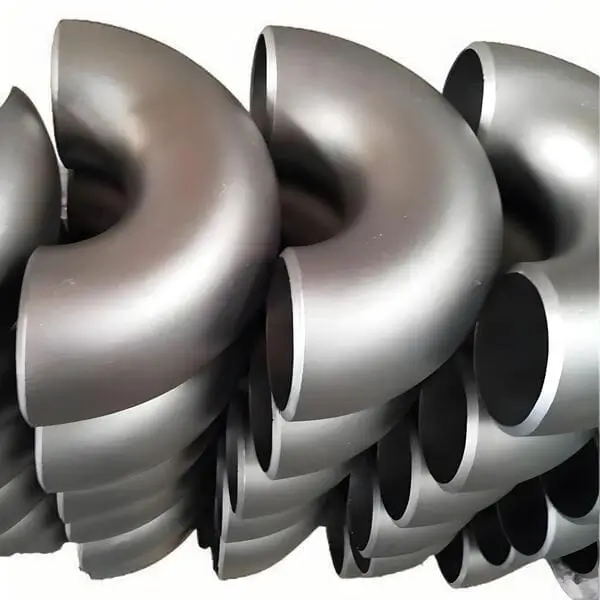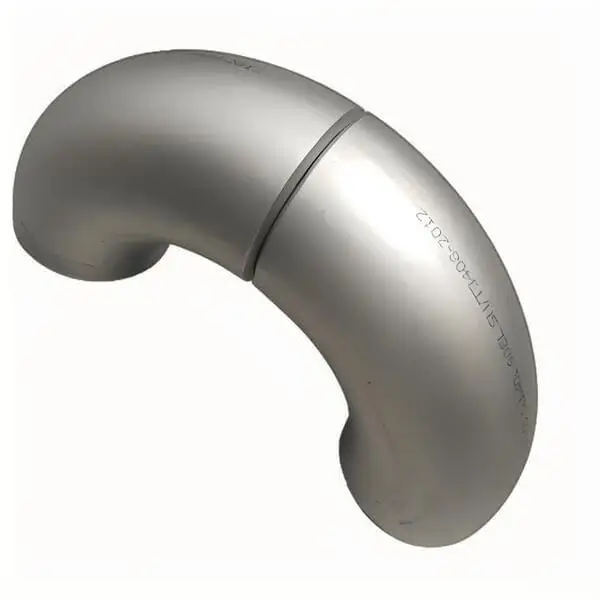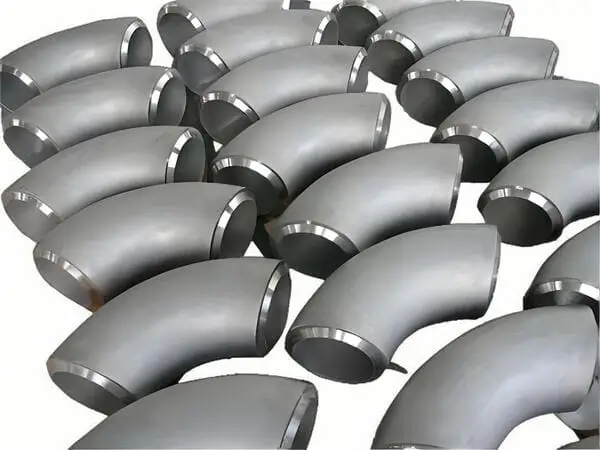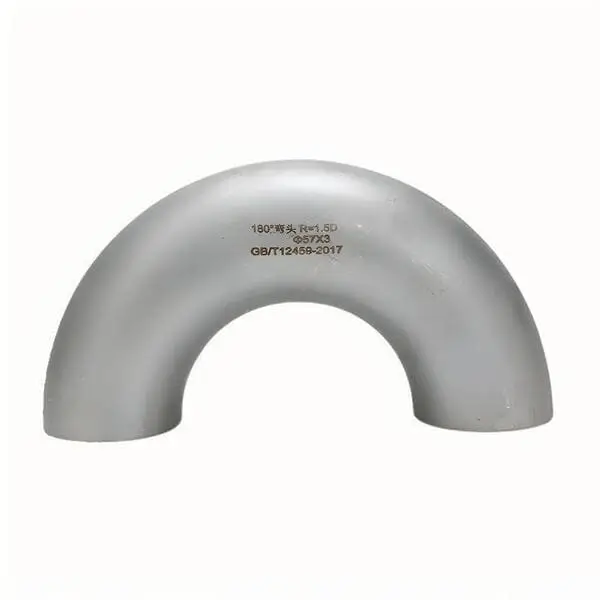What is Stainless Steel Elbow? Essential Guide to Stainless Steel Elbows
Stainless steel elbow is a standardized pipe fitting manufactured from stainless steel, engineered to change the direction of flow in a pressurized piping system. It features a defined center-to-end dimension and is produced in standard angles (typically 45°, 90°, or 180° radii) using seamless or welded construction per applicable dimensional and material specifications. Based on technical standards (ASME B16.9, B16.28, ISO 4144).
Stainless steel elbows represent indispensable components within modern piping infrastructure, enabling directional changes in fluid and gas transport systems across critical industries. Characterized by exceptional corrosion resistance, mechanical strength, and longevity, these fittings have evolved into highly specialized products meeting rigorous international standards. Understanding their technical specifications and procurement nuances is paramount for engineers and project managers.
1. Definition, Classification, and Core Characteristics of Stainless Steel Elbows
Stainless steel elbows are curved connectors facilitating directional changes in piping networks. Manufactured predominantly from austenitic (304, 316), duplex (2205), and super duplex alloys, their performance stems from chromium (Cr), nickel (Ni), and molybdenum (Mo) content, which forms a protective passive layer against oxidation and chemical attack.
Angular Classification:
- Stainless Steel 45 Degree Elbow: Enables moderate directional changes, minimizing pressure drop and turbulence in systems requiring smooth flow transition.
- Stainless Steel 90 Degree Elbow: The most prevalent type, achieving a right-angle turn; essential for navigating complex layouts in constrained spaces. Standard curvature is defined as R=1.5D (Radius = 1.5 x Pipe Diameter).
- Stainless Steel 180 Degree Elbow: Facilitates complete flow reversal, commonly deployed in pump bypass lines and specific heat exchanger configurations.
Material Classification:
- Standard Stainless Steel Pipe Fittings: Primarily grades 304 (general corrosion resistance) and 316/316L (enhanced Mo for pitting/crevice corrosion resistance in chlorides/acids). Density: ~7.9-8.0 g/cm³.
- Duplex Pipe Fittings (e.g., 2205): Blend austenitic and ferritic structures, offering roughly double the yield strength of 316L alongside superior stress corrosion cracking (SCC) resistance. Density: ~7.8 g/cm³. Key grades: UNS S31803/S32205.
- Super Duplex Pipe Fittings (e.g., 2507): Further elevated Cr, Mo, and N content compared to standard duplex. Provides exceptional resistance to pitting (PREN > 40) and chloride SCC. Density: ~7.8 g/cm³. Key grade: UNS S32750.
Manufacturing Process Classification: Includes seamless hot-formed or cold-formed elbows, welded elbows (from plate/section), and forged elbows. Common types are:
- Stainless Steel Elbow (Generic): Encompasses all angles and materials.
- Duplex Steel Elbow / Super Duplex Stainless Steel Elbow: Specifically manufactured from duplex or super duplex grades, requiring strict thermal process control to maintain phase balance and properties7.
Table 1: Key Properties of Stainless Steel Elbow Material Grades
| Material Grade | UNS Number | Key Alloying Elements (%) (Typical) | Density (g/cm³) | Pitting Resistance Equivalent Number (PREN)* | Primary Advantages | Typical Applications |
|---|---|---|---|---|---|---|
| 304 | S30400 | Cr: 18-20, Ni: 8-10.5 | 7.93 | 18-20 | Good formability, weldability; cost-effective general corrosion resistance | Water systems, food processing, architectural, mild chemical environments |
| 316L | S31603 | Cr: 16-18, Ni: 10-14, Mo: 2-3 | 7.98 | 24-26 | Enhanced corrosion resistance vs 304, esp. chlorides & acids; low carbon prevents sensitization | Chemical processing, marine, pharmaceutical, pulp & paper, coastal applications |
| Duplex 2205 | S31803/S32205 | Cr: 22, Ni: 5.5, Mo: 3.2, N: 0.17 | 7.80 | 34-36 | High strength, excellent SCC & chloride corrosion resistance, good weldability | Oil & gas (downhole, topside piping), chemical tankers, desalination, FGD systems |
| Super Duplex 2507 | S32750 | Cr: 25, Ni: 7, Mo: 4, N: 0.3 | 7.80 | >40 | Exceptional pitting/crevice corrosion resistance, highest strength, SCC resistance | Seawater systems (high velocity), offshore oil & gas (risers), chemical process severe |
*PREN = %Cr + 3.3x%Mo + 16x%N
2. Critical Procurement Considerations: Beyond Basic Specifications of Stainless Steel Elbows
Procuring stainless steel elbows necessitates meticulous attention to detail beyond standard catalog parameters to mitigate risk and ensure long-term system integrity.
Stainless Steel Elbows Material Integrity & Verification:
- Chemical Composition: Certificates (MTC) listing actual heat analysis are mandatory. Relying solely on mill test reports may be insufficient; independent verification via Portable X-Ray Fluorescence (XRF) Spectrometry is strongly recommended, especially for duplex/super duplex grades, to confirm critical elements like Cr, Mo, Ni, and N within specified limits. Spot testing with chemicals is unreliable for modern alloys and can damage surfaces.
- Material Identity Mix-ups: Risk between visually similar grades (e.g., 304 vs 316, 2205 vs 2507) necessitates rigorous traceability and testing protocols. Duplex/super duplex fittings require specific thermal treatment reports to confirm correct phase balance (typically 40-60% austenite).
- Traceability: Full heat number traceability from raw material to finished fitting is crucial for critical applications (ASME B16.9, EN 10253-4).
Stainless Steel Elbows Precision Dimensions & Dimensional Tolerances:
- Center-to-End (C) / Radius of Curvature (R): For 90° elbows, R=1.5D is the ASME B16.9 standard. However, non-standard R=1.25D elbows are often encountered, reducing material usage (potentially by 10-15%) and cost, but also potentially compromising flow efficiency and erosion resistance. Explicit specification of required
Ris essential. Deviations can negatively impact pressure drop calculations. - Wall Thickness Control – Critical Aspect: The manufacturing process (especially hot induction bending) inherently causes wall thinning (“extrados thinning”) on the outer curve of the bend. While standards (e.g., ASME B16.9) permit some variation, rigorous inspection is vital:
- Ultrasonic Testing (UT): Essential post-forming UT mapping, particularly across the bend extrados, ensures minimum wall thickness meets design pressure requirements after thinning. Relying solely on nominal wall thickness or measuring only straight sections is inadequate.
- Supplier Process Capability: Evaluation of the supplier’s process control (e.g., mandrel type, heating control) is paramount for consistent wall thickness distribution, especially for thick-walled or large-diameter elbows and critical-service duplex elbows.
- Out-of-Roundness & Bevel Dimensions: Can significantly impact fit-up and welding quality, especially for alloyed materials like duplex requiring strict heat input control.
- Center-to-End (C) / Radius of Curvature (R): For 90° elbows, R=1.5D is the ASME B16.9 standard. However, non-standard R=1.25D elbows are often encountered, reducing material usage (potentially by 10-15%) and cost, but also potentially compromising flow efficiency and erosion resistance. Explicit specification of required
Table 2: Procurement Checklist for Stainless Steel Elbows
| Category | Key Parameter/Requirement | Verification Method | Criticality for Risk Mitigation |
|---|---|---|---|
| Material | Grade Confirmation (304, 316L, 2205, 2507 etc.) | Independent XRF Spectrometry on delivered goods; Review MTC with Heat No. | High (Mix-ups common) |
| Chemical Composition (Actual Cr, Ni, Mo, N etc.) | Verify against MTC heat analysis; Spot XRF for key elements | Critical for Duplex/Super Duplex (N content) | |
| Material Certification (MTC) | Supplier must provide full MTC traceable to Heat No. (EN 10204 3.1/3.2) | Mandatory | |
| Phase Balance (Duplex/Super Duplex only ~40-60% Austenite) | Supplier to provide Feritscope report or metallographic report; Destructive testing on coupons if critical service | Critical for Duplex/Super Duplex Performance | |
| Dimensions | Nominal Pipe Size (NPS/DN) & Schedule/Wall Thickness | Calipers, Ultrasonic Thickness Gauge (UTG) on straight sections (Incoming) | High |
| Center-to-End (C) / Radius (R) | Precision measurement (Caliper, Template); Explicitly specify R=1.5D or required alternative | High (Flow/Pressure Drop) | |
| Wall Thickness – Extrados (Outer Bend) | Mandatory Ultrasonic Testing (UT) mapping across entire bend extrados; Compare UT results to design min. wall post-thinning | Critical (Pressure Integrity, Erosion) | |
| Out-of-Roundness | Calipers/Micrometer at multiple points; Visual inspection for obvious deformation | Medium-High (Fit-up/Welding) | |
| Bevel Angle/Land | Bevel gauge | High (Welding Integrity) | |
| Surface/Quality | Surface Finish (e.g., #4, 180Grit, EP) | Visual comparison to sample; Roughness gauge if specified | Medium (Hygiene, Corrosion Initiation) |
| Visual Defects (Pits, Scratches, Roll Marks, Scale) | Thorough visual inspection | Medium | |
| Certification of Non-Destructive Testing (NDT) – PT, RT, UT (if specified) | Review certified NDT reports per procedure (e.g., ASME V, ISO 17635) | Critical for High-Pressure/Severe Service | |
| Supplier | Quality Management System Certification (ISO 9001) | Verify certificate validity | Foundational |
| Material Traceability System | Audit trail from PO to Heat No. to MTC to fitting marking | Critical for Compliance & Failure Analysis | |
| Technical Capability (Experience with Alloy/Dimensions) | Evaluate past project references; Audit manufacturing process if high-value/critical | High for Complex/Duplex Elbows | |
| Lead Time Realism | Detailed schedule review; Buffer inclusion; Assess capacity/backlog | High (Schedule Risk) |
Manufacturing Quality & Certification:
- Surface Finish: Requirements vary significantly:
- Sanitary/Hygienic (Tri-Clamp) Elbows: Demand high-polish finishes (e.g., Ra ≤ 0.38 µm / 15 µin) to prevent bacterial adhesion, verified by surface roughness comparators.
- Industrial Elbows: Typically require shot blasted or pickled/passivated finishes to remove scale and enhance the passive layer formation (ASTM A380/A967).
- Non-Destructive Testing (NDT): Scope depends on service severity:
- Dye Penetrant Testing (PT): Mandatory for surface crack detection on all critical service elbows (ASME B16.34).
- Radiographic Testing (RT): Essential for detecting internal volumetric defects (porosity, inclusions) in thick-walled elbows or severe cyclic service applications.
- Positive Material Identification (PMI): Recommended for alloy verification at receiving, complementing supplier MTCs.
- Passivation: Post-fabrication chemical treatment (typically nitric or citric acid based) to remove free iron and enrich the chromium oxide layer is essential for optimal corrosion resistance, particularly for welded elbows.
- Surface Finish: Requirements vary significantly:
Supplier Qualification & Logistics:
- Technical Capability: Assess the manufacturer’s specific experience with the required alloy (especially duplex/super duplex welding and forming) and elbow dimensions/type. Proven capability reduces risk.
- Quality Management: ISO 9001 certification is foundational. Review procedures for traceability, testing, and non-conformance handling.
- Lead Time Realism: Accurately gauge manufacturing capacity. “Expedited” production for complex items like large diameter or thick-wall duplex elbows may compromise quality or necessitate unrealistic overtime. Buffer periods should be incorporated into project schedules.
- Packaging & Preservation: Essential to prevent damage (dents, scratches) and surface contamination (chlorides, fingerprints) during transit and storage, especially for polished or passivated finishes. VCI (Vapor Corrosion Inhibitor) packaging may be warranted for marine transport or extended storage.
3. Advanced Applications Leveraging Material Properties of Stainless Steel Elbows
The unique properties of different stainless steel grades and duplex alloys enable deployment in the most demanding environments:
- Chemical & Petrochemical Processing: 316L stainless steel elbows resist sulfuric and acetic acids. Duplex 2205 and Super Duplex 2507 stainless steel elbows handle aggressive chloride-containing streams, acidic crude oils, and elevated temperatures where SCC is a major concern, replacing higher-cost nickel alloys. High-purity electropolished systems are crucial.
- Oil & Gas Exploration & Production:
- Subsea/Offshore: Super Duplex Stainless Steel Elbows (2507) are standard for high-pressure flowlines, risers, manifolds, and umbilicals due to unparalleled resistance to seawater pitting/SCC and high strength-to-weight ratio.
- Downhole/Topside: Duplex Steel Elbows (2205) offer cost-effective corrosion resistance and high strength for production tubing, casing, and processing piping handling corrosive hydrocarbons and H₂S.
- Desalination & Seawater Systems: Super Duplex 2507 elbows dominate high-velocity seawater intake, brine handling, and high-pressure RO piping due to immunity to crevice corrosion under deposits at elevated temperatures.
- Power Generation (Fossil & Nuclear): 304/316L stainless steel elbows serve condensate and feedwater systems. Specialty grades like 904L or 6% Mo austenitics handle flue gas desulfurization (FGD) scrubber environments. Duplex alloys find use in cooling circuits.
- Pulp & Paper: Duplex 2205 elbows withstand corrosive pulping liquors (sulfite/sulfate) and bleach plants, offering longer life than 316L.
- Food, Beverage & Pharmaceutical (CIP/SIP Systems): Highly polished 304L/316L sanitary elbows with orbital welds ensure cleanability, sterility, and prevention of product contamination, complying with FDA, EHEDG, and 3A standards.
4. Installation and Operational Best Practices
Proper handling and installation are crucial to realizing the designed performance:
- Storage & Handling: Store indoors in clean, dry conditions. Protect polished surfaces with film. Use nylon slings to prevent surface damage. Keep duplex/super duplex segregated from carbon steel to prevent iron contamination.
- Installation Alignment: Ensure accurate fit-up before welding. Misalignment creates stress concentrations detrimental to fatigue life and corrosion resistance. Use appropriate alignment clamps.
- Welding Procedures:
- Austenitic (304/316): Use matching or over-alloyed filler metals (e.g., ER308L, ER316L). Control heat input to avoid sensitization (carbide precipitation). Back purging with argon is critical internally to prevent sugaring on welds.
- Duplex/Super Duplex: Requires strict procedure qualification (WPS/PQR). Use duplex/super duplex filler metals (e.g., ER2209, ER2594). Precise control of interpass temperature (typically <150°C / 300°F) is critical to maintain phase balance and avoid nitride precipitation or excessive ferrite. 100% back purging mandatory.
- Post-Weld Treatment: Remove heat tint (via grinding and re-passivation or specialized pickling pastes) on both austenitic and particularly duplex welds to restore corrosion resistance in the heat-affected zone (HAZ).
- Commissioning & Operation: Conduct thorough cleaning (flushing) before service to remove debris/welding slag. Ensure operating conditions (temperature, pressure, chemistry) stay within design limits for the selected material grade. Implement regular inspection regimes (visual, UT thickness monitoring).

Conclusion
The selection and procurement of stainless steel elbows—spanning common stainless steel 45 degree, 90 degree, and 180 degree elbows to advanced duplex pipe fittings and super duplex pipe fittings—demand a sophisticated, multi-faceted approach. Moving beyond basic dimensional catalog specifications requires rigorous focus on validated material chemistry (particularly for duplex/super duplex grades), precise verification of critical dimensions like wall thickness distribution post-forming, comprehensive quality assurance certifications (NDT, MTC),
and supplier process capability assessment. Integrating this technical diligence ensures optimal performance across extreme applications, from subsea oil extraction utilizing super duplex stainless steel elbows to sterile pharmaceutical processing relying on polished stainless steel pipe fittings. Adherence to installation protocols further safeguards the significant investment in these high-performance components, delivering long-term reliability and operational safety.



